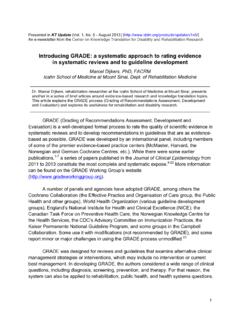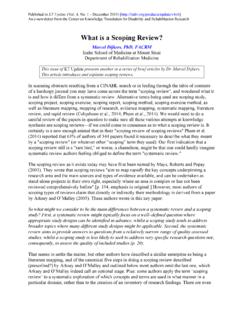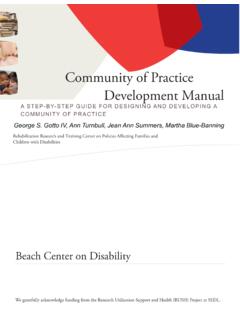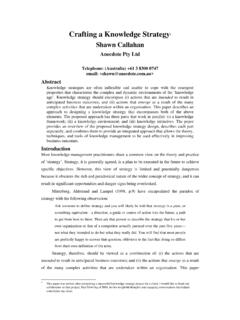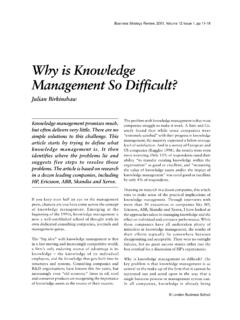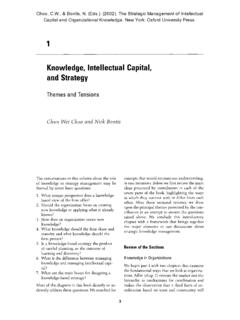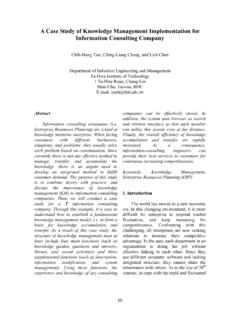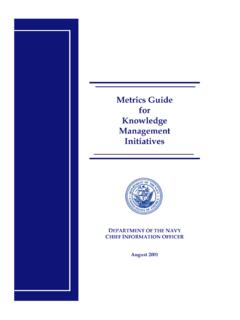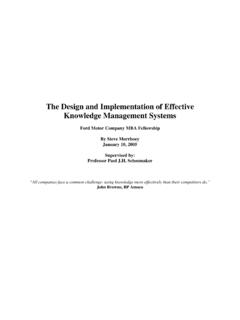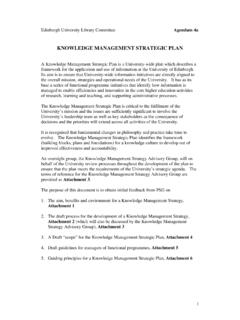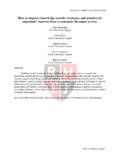Transcription of What is Knowledge Translation? - KTDRR Center
1 Technical Brief Number 10 The term Knowledge translation (KT) is increasing in importance and use in the fields of public health, medicine, and rehabilitation research (Brandt & Pope, 1997; CIHR, 2004; Davis et al., 2003; Glasgow, Lichtenstein, & Marcus, 2003; Jacobson, Butterill, & Goering, 2003; Tingus, Berland, Myklebust, & Sherwood, 2004). KT is a relatively new term that is used to describe a relatively old problem the underutilization of evidence-based research in systems of care. Underutilization of evidence-based research is often described as a gap between what is known and what is currently done in practice settings (Davis et al., 2003; Grol, 2000; Grol & Grimshaw, 2003). KT has also emerged as an important concept for the National Institute on Disability and Rehabilitation Research (NIDRR).
2 NIDRR has remarked that KT plays an important role in enhancing the lives of individuals with disabilities, as science-based Knowledge , technologies, and applications must be translated in order to inform disability and rehabilitation policy and improve practice (Tingus et al., 2004). How is Knowledge translation Defined?The term Knowledge translation most readily appears in medical and health-care literature and primarily pertains to the assessment, review, and utilization of scientific research. One of the most well-known references for KT hails from the Canadian Institutes for Health Research (CIHR). CIHR defines KT as the exchange, synthesis, and ethically-sound application of Knowledge within a complex set of interactions among researchers and users to accelerate the capture of the benefits of research for Canadians through improved health, more effective services and products, and a strengthened health care system (CIHR, 2004).
3 For the CIHR, the primary purpose of KT is to address the gap between the large volume of research data and its systematic review and implementation by key stakeholders (Ohlsson, 2002). In Canada and the United Kingdom, where the term KT is commonly used, researchers have focused their attention on KT as both a process and a strategy that can lead to utilization of research findings and improved outcomes for consumers, students, and patients (CIHR, 2004; Dobbins, Ciliska, Cockerill, Barnsley, & Di, 2002; Landry, Lamari, & Amara, 2003; Nutley, Walter, & Davies, 2003). While the term KT may appear similar to dissemination or diffusion, it can be differentiated by its emphasis on the quality of research prior to dissemination and implementation of research evidence within a system.
4 Unlike simple dissemination activities ( , distributing user friendly information, developing research briefs, etc.), KT requires coordination and process improvement amongst a complex system to influence behavior change and patient outcomes (Davis et al., 2003). Furthermore, it differs from the traditional diffusion process because KT is primarily an active and manipulated process that involves all steps between the creation of new Knowledge and its application and use to yield beneficial outcomes for society (CIHR, 2004, p. 4). In an effort to advance KT, several academic programs and international organizations have established centers that conduct KT-related research, development, and dissemination activities, including the following: Agency for Healthcare Research and Quality (AHRQ) Translating Research Into Practice (TRIP) Program: An initiative focusing on implementation techniques and factors associated with successfully translating research findings into diverse applied settings ( ) Campbell Collaboration (C2): An international organization that conducts systematic reviews of education, social welfare, and social science research ( ) Canadian Institute for Health Research (CIHR).
5 The major federal agency responsible for funding health research in Canada that has established charges for KT research, development, and dissemination ( ) Technical Brief National Center for the Dissemination of Disability ResearchFocusWhat is Knowledge translation ? Knowledge translation involves more than distribution of practical scientific information and reliance on academic publication as a primary mechanism for disseminating (2004). Knowledge translation strategy 2004 2009: Innovation in Action. Ottawa, ON: Canadian Institutes of Health CIHR conceptualizes KT as an acceleration of the Knowledge Cycle Model, which consists of seven bilateral stages. There is recognition in the CIHR definition that KT stages must consider coordinated communication, marketing, and training to facilitate KT.
6 The seven stages are the following: Research priority setting Research Knowledge priority setting Knowledge synthesis Knowledge distribution and application Use Evaluation of uptakeAuthor(s)Key characteristicsLogan, J., & Graham, I. D. (1998). Toward a comprehensive interdisciplinary model of health care research use. Science Communication, 20(2), 227 Ottawa Model of Research Use (OMRU) is a logic model approach for planning dissemination and Knowledge utilization and for managing results. It features six primary elements and requires attention to a continuous assessment, monitoring, and evaluation process. The six elements are the following: Practice environment Potential adopters of the evidence Evidence-based innovation Research transfer strategies Evidence of adoption Health-related and other outcomesTable 1.
7 Selected KT Planning Models2 Technical Brief Number 10 NCDDRC ontinued on next page Cochrane Collaboration: An international organization that conducts systematic reviews of health and medical research ( ) Knowledge translation Program (KTP) at the University of Toronto, Canada: A multidisciplinary academic program developed to address the gap between research evidence and clinical practice and the need to focus on the processes through which Knowledge is effectively translated into changed practices ( ) Knowledge Utilization Studies Program at the University of Alberta, Canada: A health research program focusing on nursing, the social sciences, and research utilization in the nursing profession ( ) National Health Service (NHS) Centre for Reviews and Dissemination at the University of York: An organization that conducts systematic reviews of research and disseminates research-based information about the effects of interventions used in health and social care in the United Kingdom ( ) what Works Clearinghouse (WWC).
8 A clearinghouse established by the Department of Education s (ED s) Institute of Education Sciences to provide educators, policymakers, and the public with a central, independent, and trusted source of scientific evidence of what works in education ( ) what is the KT Planning Process?There are planning models that self-identify as KT approaches (CIHR, 2004; Jacobson et al., 2003) and several more that are frequently cited in reference to KT, such as the Ottawa Model of Research Use (Logan & Graham, 1998) or the Lavis framework (Lavis, Robertson, Woodside, Mcleod, & Abelson, 2003). In addition, numerous authors, particularly in medical and health-care literature, have described the KT process as consisting of multiple stages designed to identify research gaps and plan for evidence-based implementation (Backer, 2000; Glasgow et al.)
9 , 2003; Little & Houston, 2003; Roy, 1999). These models vary in their descriptions and emphasis; however, most authors agree that KT is a complex and lengthy process, and one that requires innovative and dedicated action on the part of knowledgeable strategic planners and change agents (Brandt & Pope, 1997). Table 1 summarizes several KT planning : KT and the NCDDRK nowledge translation (KT) is a relatively new term that is increasing in importance and use. KT involves more than distribution of practical scientific information and reliance on academic publication as a primary mechanism for disseminating results. KT implies an interactive and engaged process between the research and systems of care ( , teams, populations, policymakers, and consumers) (Jacobson et al.
10 , 2003). Also, there are several planning models that discuss the KT process and KT strategies. However, there is a need to refine the definition of KT to reflect the disability and rehabilitation research and development priorities supported by NIDRR. In refining this concept, the National Center for the Dissemination of Disability Research (NCDDR) suggests that KT is Technical Brief Number 10 NCDDRR esearch implementation model Various authorsNumerous authors have described research implementation as a process consisting of multiple stages designed to reduce the gap between research evidence and practice (Grol, 2000). These models are described using a circular process, a continuous improvement approach (National Cancer Institute, 2002), and an iterative process (Caburnay, Kreuter, & Donlin, 2001; Demakis, McQueen, Kizer, & Feussner, 2000).

